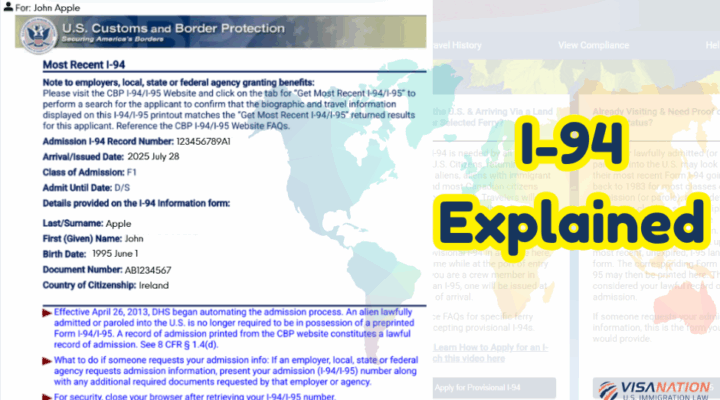Form I-94 is a record of arrivals and departures issued to foreign visitors admitted to the United States. Understanding your I-94 expiration date is critical, as it dictates how long you are authorized to remain in the U.S., regardless of your visa’s printed expiration. U.S. Customs and Border Protection (CBP) issues I-94s electronically to those entering the country via air or sea. For individuals entering the U.S. by land, you may still receive a paper I-94.
What is the I-94?
Every visitor who is a non-citizen receives an I-94. International travelers visiting the United States can apply for this in advance using the CBP Home mobile app (available on Apple and Android devices) or the CBP website. The I-94 admission number/record is proof of legal visitor status.
What You’ll See on Your I-94
On your I-94 record, you’ll typically find:
-
Admit Until Date – This will either be:
-
A specific date, indicating the last day you’re authorized to stay in the U.S., or
-
D/S (Duration of Status), which means you can stay as long as you maintain the conditions of your status (common for student visas)
-
-
Class of Admission – This is the visa category you used to enter the U.S. (e.g., H-1B, L-1A, F-1)
How to Check Your I-94
You can check your I-94 by:
Step 1: Visiting the U.S. Customs and Border Patrol I-94 Website
Website: https://i94.cbp.dhs.gov/search/compliance-search
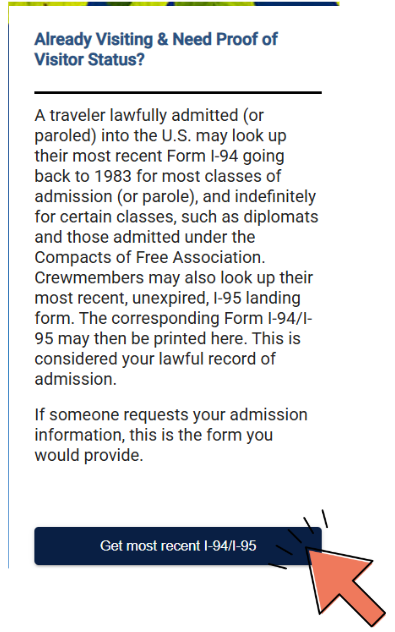
Step 2: Fill out the information on the form
This includes your name, date of birth, country of citizenship, and document (often passport) number.
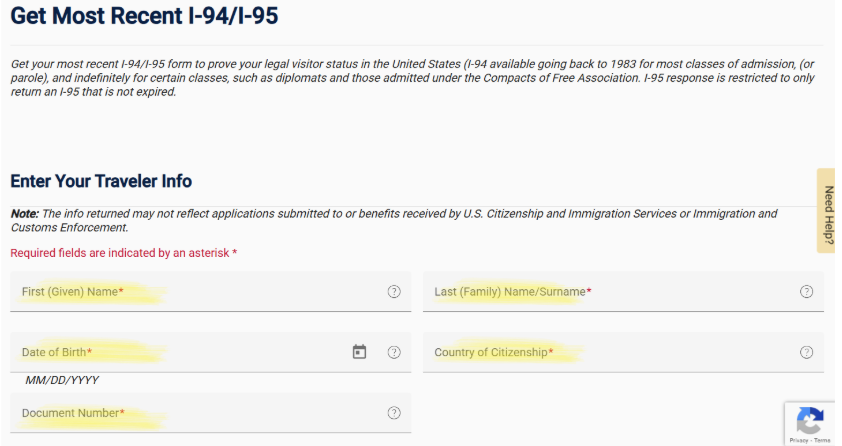
Step 3: View Results
The I-94 compliance page provides information on how much time you have to remain in the United States.
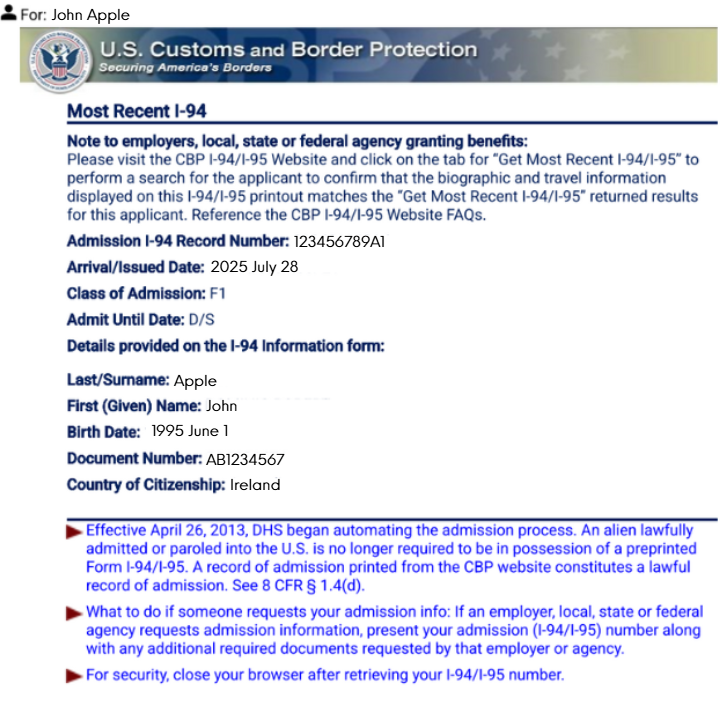
Duration of Stay: Date vs. D/S
If your I-94 has a date, you can stay in the U.S. until that specified date. The last allowed date includes the day you must depart by.
If you are a tourist or H/L class worker, you will most likely receive a departure date marked on your I-94 form.
In contrast, some students and exchange program participants have a duration of status (D/S) marked on their I-94. This means that they can stay in the United States as long as they legally maintain their status (e.g. maintain enrollment in their studies, working, etc.)
You will commonly see the D/S marked on I-94 forms for F-1 students and J-1 exchange visitors.
How to Find the I-94 Expiration Date
The I-94 expiration date serves as the official record of how long you are permitted to remain in the United States.
The expiration date for your I-94 is located in the lower right-hand corner of the page.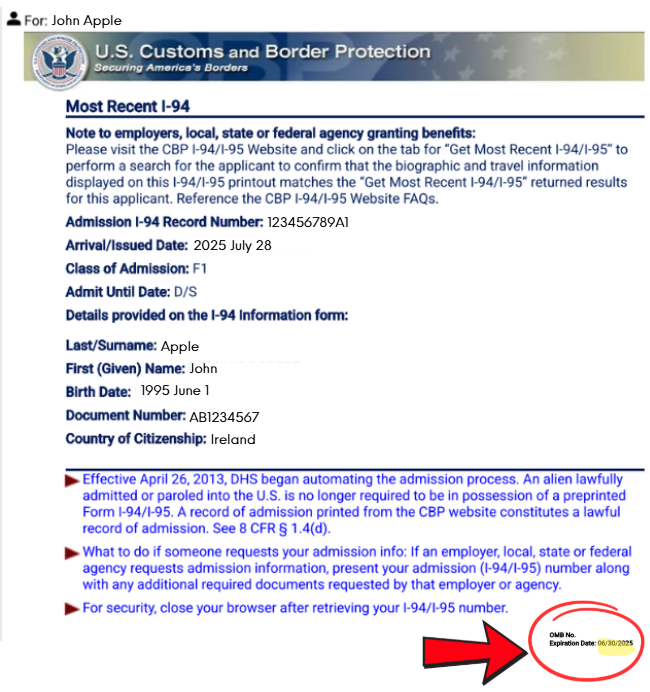
Difference Between Visa Expiration Date and I-94 Admit Until Date
There are two dates to be aware of on the I-94 form: the “expiration date” and the “admit until date.”
The visa expiration date is the last day you can use your visa to enter the United States. The I-94 “Admit Until” date indicates how long you are allowed to stay in the U.S. after entry. Importantly, this determines your authorized period of stay, not the visa. In many instances, the I-94 expiration date comes before the visa expiration date.
While you may hold a multiple exit/re-entry visa, commonly valid for 10 years, your I-94 record may only indicate a validity period of 6 months. In a case like this, you will need to depart within 6 months. Alternatively, you will have to apply for an extension to stay longer.
The key takeaway is that your I-94 admit until date determines the authorized length of stay in the United States. If you stay past your I-94 expiration date, you become “out of status.” In this case, you may be barred from reentering, which can lead to more problems, including arrest and deportation by U.S. authorities.
I-94 and Student Visas
Foreign national students are usually issued a visa (F-1 or J-1) for longer periods that reflect their studies. While their visas occasionally have a specified expiration date, the I-94 typically presents an expiration status of “D/S.” This means the student can stay in the US as long as they maintain their visa status. The requirements for maintaining visa status can differ for the various visa categories.
Example: Imagine an F-1 student who takes on a full course load. They maintain a valid I-20, among other requirements, which allows them to maintain their legitimate student visa status for the length of their studies.
Tourism and Business Visas
Non-U.S. citizens and non-immigrants who travel for tourism or business purposes may receive visas that extend far beyond the authorized length of stay for each visit.
B-1/B-2 visas can be for up to 10 years. However, tourists typically can only stay for a maximum period of six months for each trip. The individual would then need to exit and re-enter the country. They may even receive an additional period of stay. However, if the individual abuses this system and the pattern of stay is inconsistent with the visa class, they may have their visa revoked and denied entry permission.
Apply for a New I-94
If you are arriving by an air or sea port of entry, you do not need to use the website to apply for an I-94, as you will receive an electronic I-94. Individuals who are applying by land or selected ferry will need to apply for the I-94 on the website.
You can apply for a new I-94 by going to the U.S. Customs and Border Protection website page and clicking on “Apply for I-94” in the top navigation bar. You will fill out the applicable information below.
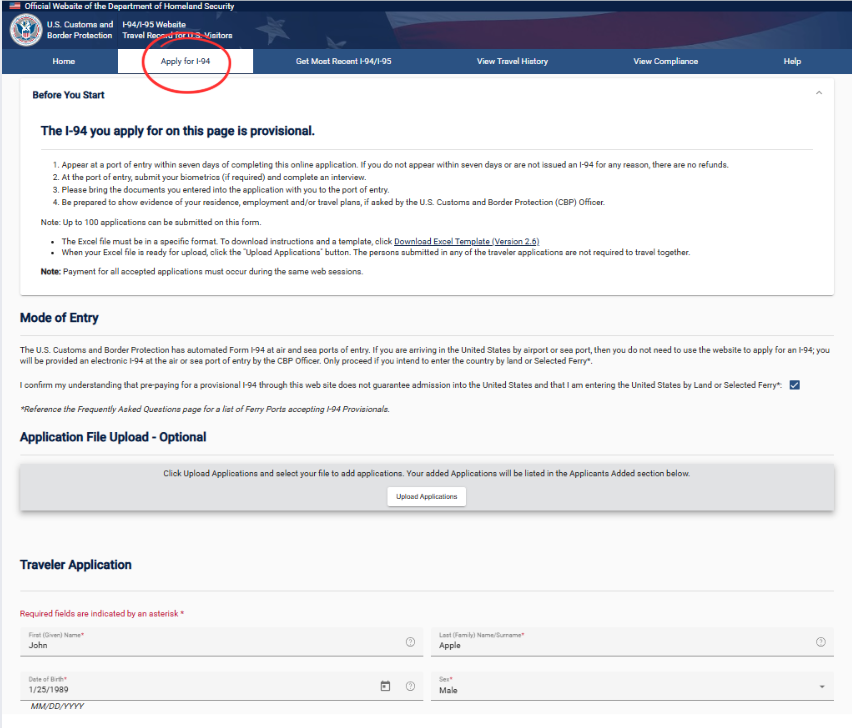
Am I Eligible to Extend My Stay?
Many nonimmigrant visa holders, like F-1. H-1B, L-1, O-1, etc., may apply to extend their status before their I-94 expires. You mustn’t overstay your I-94 dates, as this can lead to visa cancellations and barred reentry into the U.S.
However, if you were admitted under any of the following categories, you cannot extend your stay in the U.S. once your I-94 expires:
- C (Passing through the U.S. en route to another country)
- D (Crewman on ships/aircraft)
- K-1/K-2 (Fiance(e) or Dependent of Fiance(e)
- S (Witness or Information beyond a total of 3 years)
- TWOV (Transit Without Visa)
- WT/WB (Visa Waiver Program)
Entry Information Errors
The I-94 date record is ultimately a human process, even if it is digital. Mistakes can still happen. It is advisable to visit the official I-94 website and retrieve your I-94 record after arrival to confirm the length of your authorized stay. If you notice a mistake, then go to the nearest Customs & Border Protection (CBP) office, which you can find in an international airport. An alternative is to visit one of over 70 Deferred Inspection Sites in the United States.
Staff at Deferred Inspection Sites can review and correct several issues. These include I-94 entry records. They also include errors in biometric information and improper non-immigrant classification.
I-94 Frequently Asked Questions
Do I get a paper or electronic I-94 form?
As of 2025, most I-94s are electronic. However, for certain land and ferry point entries, a physical paper I-94 may be given.
What happens if I stay in the U.S. past my I-94 admit until date?
You will be considered "out of status" once you overstay your I-94 admit until date, and this can lead to serious consequences like barred reentry or cancellations of your visa.
Are Canadian citizens required to have an I-94 when visiting the U.S.?
No, Canadian citizens are not required to have an I-94 when visiting the U.S.
How do I know if I am eligible to extend my I-94 status?
Many nonimmigrant visas allow extensions for your I-94, but you must file the extension before your I-94 expires.









